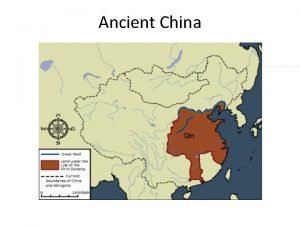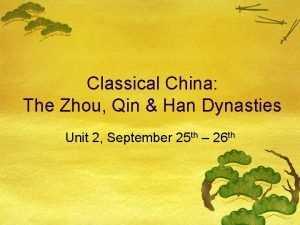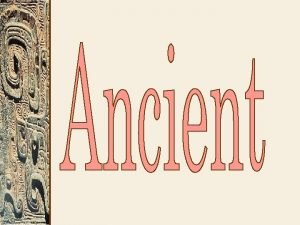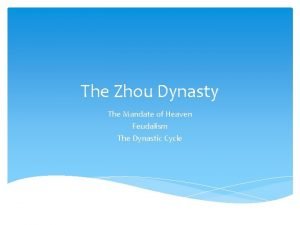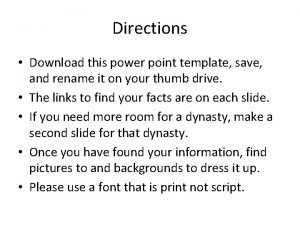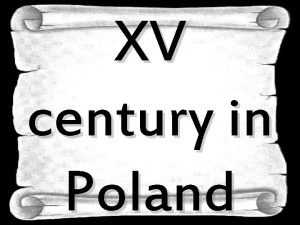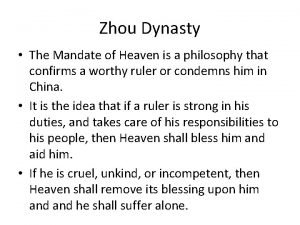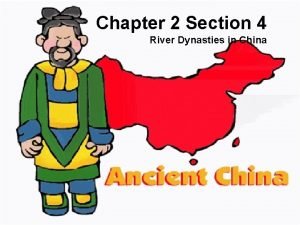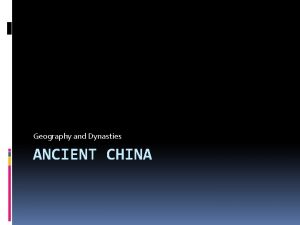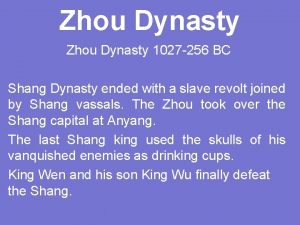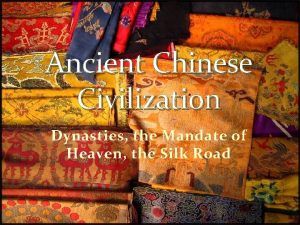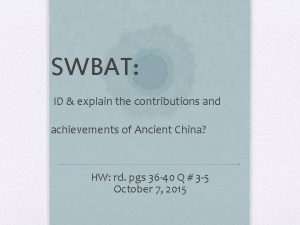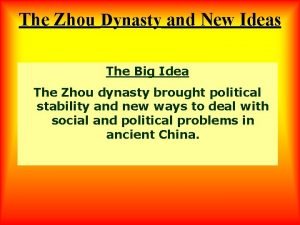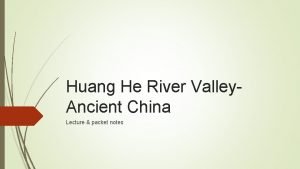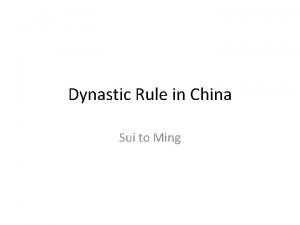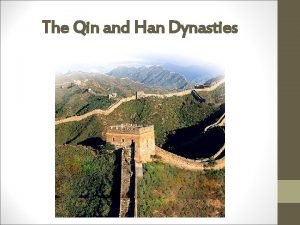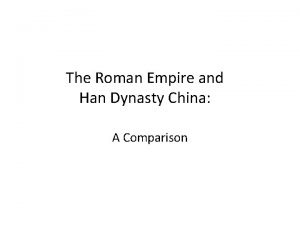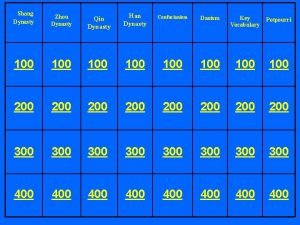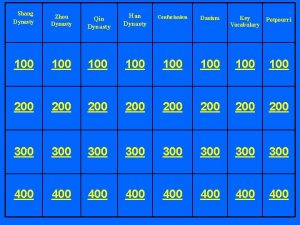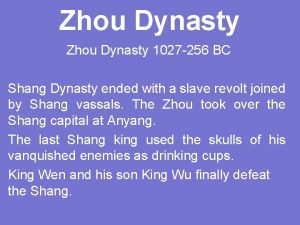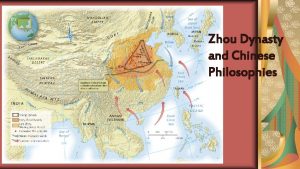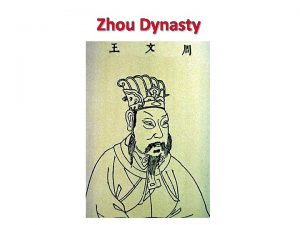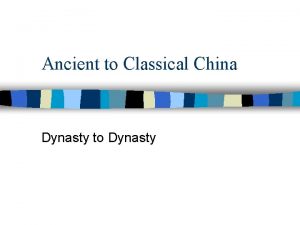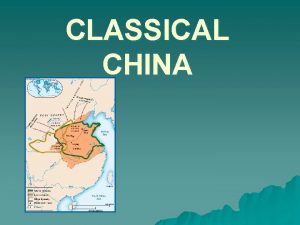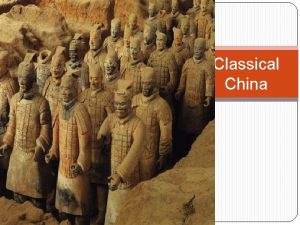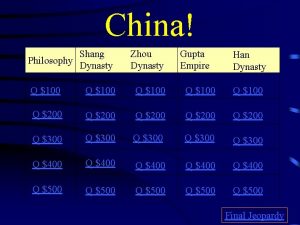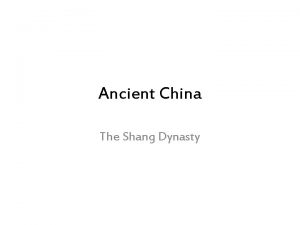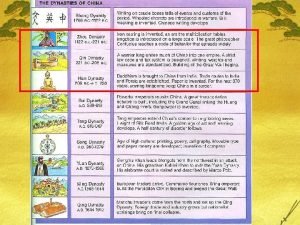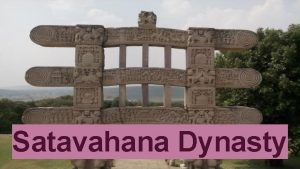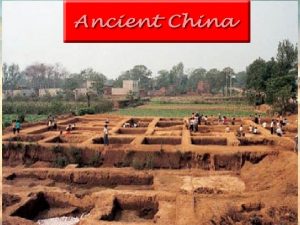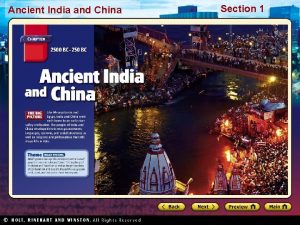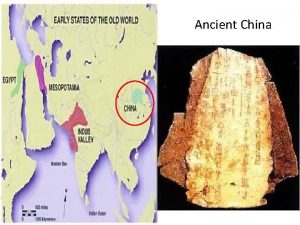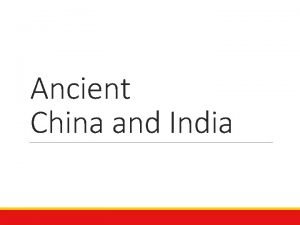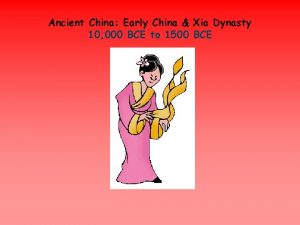Ancient China India Zhou Dynasty Overthrown In 256






















- Slides: 22

Ancient China & India

Zhou Dynasty Overthrown • In 256 B. C. E. the Zhou Dynasty was overthrow

The Qin Dynasty • By 221 B. C. E. a man by the name of Qin had overthrew the Zhou Dynasty, and all other opposition, • He placed himself as the ruler of

“China”: from “Qin” The Qin Dynasty only lasted about 11 years. The Qin dynasty made changes that effected the history of China for thousands of years. So influential was Qin, that the name of the nation,

Qin Shi Huangdi • Qin named himself Qin Shi Huangdi, which means Qin, the first emperor of China.

Centralization of Authority Qin Shi Huangdi reorganized China. v. Established a strict set of written laws. v. Setup military control in each region of China. v. Qin wanted everything to be under his direct authority and

Qin Building • Qin forced the peasants, Projects to build roads, bridges, canals, buildings, and the Great Wall of China. • Qin ordered the connection of existing walls and expanded them, to a distance of over 4000 miles. • Over 300, 000 peasants were forced to build the Great Wall. Many died during the construction.

The Han Dynasty • In 207 B. C. a new dynasty came to power. • Led by a peasant whose named Liu Bang. • Liu Bang proclaimed that the Qin had lost the mandate of heaven, or the right to rule the nation. • He established himself as the first emperor of the Han Dynasty. • The Han Dynasty ruled China for the next 400 years. Peace thru war and plunder.

Four Hundred Year Rule • The Han made China one of the wealthiest and most powerful nations on Earth. • Their achievements would only be surpassed by the Roman Empire. • China was isolated from much of the rest of the world.

Chinese Exploration • In 139 B. C. E. , emperor Wudi sent general Zhang Qian, to explore other nations. • This general and his army visited other civilizations and nomadic tribes. • The armies of Zhang Qian were attacked and destroyed by the nomadic tribes many of Zhang Qian's men. • Zhang Qian himself was held prisoner for 10 years. • Qian returned with stories of a great civilization to the West that equaled China.

The Silk Road • Emperor Wudi began to develop the silk road. • Merchant traders took silk from China to the West, and brought glass, linen, and gold back to China. • The silk road stretched across nearly 5000 miles of land water.

Pax Sinica • During the Han Dynasty, China enjoyed a 400 year period of peace and prosperity. • Han emperors established: vstrong central government. v. Improved storage of food. vwritten exams for

Chinese Dynasties and Their Achievements Dynasties Xia Dynasty 2100 -1800 B. C. E. Notable Rulers Aryans Achievements • Migrated into the area and conquered the local peoples Developed superior weaponry and technology • Shang Dynasty 1500 -1100 B. C. E. Thirty separate kings • • Ruled from a succession of seven different capitals. Invention of writing Zhou Dynasty 1122 -256 B. C. E. Kings + Noblemen • • Expansion Regional rulers Qin Dynasty 221 -206 B. C. E. Qin • • • Centralization of authority Written laws Building projects (Great Wall of China) Han Dynasty 207 B. C. E. – 220 C. E. Han Wudi • • 400 year rule Exploration (Zhang Qian) Expansion of trade Silk Road Pax Sinica Food reserves Merit-based appointments

Chinese Philosophies/Religions Philosophy/ Religion Founders Characteristics Confucianism Confucius (Kongzi) • • • Peace and order Respect for elders Ethical human relationships Daoism Laozi • • • Reject material things Commune with nature Become one with Dao (force within all things) Buddhism Budda • • Four Noble Truths Eightfold path Nirvana Harmony with the universe

The Mauryan and Gupta empires 321 B. C. E. -550 C. E.

Chandragupta Maurya • Founder of Maurya Empire - 1 st unified Indian empire § Unified northern India. § Divided his empire into provinces, then districts for tax assessments and law enforcement. § He feared assassination food tasters, slept in different rooms, etc.

Ashoka (304 – 232 BCE) • Grandson of Chandragupta • Represents high point of Mauryan Empire, 268 -232 BCE • Expanded empire to include all of Indian subcontinent except for south • Positive leadership integrated Indian society § Religious conversion after the battle of Kalinga in 262 BCE. § Dedicated his life to Buddhism. § Built extensive roads. § Conflict how to balance methods of keeping power and Buddhism § Wrote law code on rocks or pillars (Stupas) § Buddhist principles dominate his laws.

Decline of the Mauryan Empire • Economic crisis follows death of Ashoka • Regions begin to abandon Mauryan Empire – Disappears by 185 BCE

The Gupta Empire • Founded by Chandra Gupta, c. 320 CE • Highly decentralized leadership • Foundations for studies in natural sciences and mathematics • Great Rulers § Chandra Gupta I - “Great King of Kings” r. 320 – 335 CE § Chandra Gupta II r. 375 - 415 CE § Profitable trade with the Mediterranean world! § Hindu revival.

Gupta Achievements 1000 diseases classified Printed medicinal Kalida guides sa 500 healing plants identified Plastic Surger y Medicine Inoculatio ns Gupta CIndia sections performe d Mathematics Decima l PI = System. Conce 3. 1416 pt Literature Solar Calendar Astronomy The earth is round

Gupta Decline • Frequent invasions of White Huns, 5 th c. CE • Gupta Dynasty disintegrates along regional fault lines • Smaller local kingdoms dominate until Mughal Empire founded in 16 th c.

The Caste System • Caste system from Aryan times – Brahmins (priests) – Kshatriyas (warriors, aristocrats) – Vaishyas (Peasants, merchants)
 Ancient china zhou dynasty
Ancient china zhou dynasty Zhou dynasty wars
Zhou dynasty wars Zhou
Zhou China zhou dynasty
China zhou dynasty Ancient india vs ancient china
Ancient india vs ancient china Mandate of heaven example
Mandate of heaven example Zhou dynasty facts
Zhou dynasty facts Zhou dynasty map
Zhou dynasty map Fall of the zhou dynasty
Fall of the zhou dynasty Zhou dynasty social pyramid
Zhou dynasty social pyramid Zhou dynasty geography
Zhou dynasty geography The zhou dynasty ended in
The zhou dynasty ended in Zhou dynasty achievements
Zhou dynasty achievements Achievements of xia dynasty
Achievements of xia dynasty Zhou dynasty politics
Zhou dynasty politics Huang ho river valley civilization
Huang ho river valley civilization How did the sui dynasty affect daily life in china
How did the sui dynasty affect daily life in china Four chinese dynasties
Four chinese dynasties Both the han dynasty and the roman empire
Both the han dynasty and the roman empire The ming dynasty ended rule of china.
The ming dynasty ended rule of china. Sui dynasty contributions
Sui dynasty contributions Princess anle
Princess anle China dynasty
China dynasty

